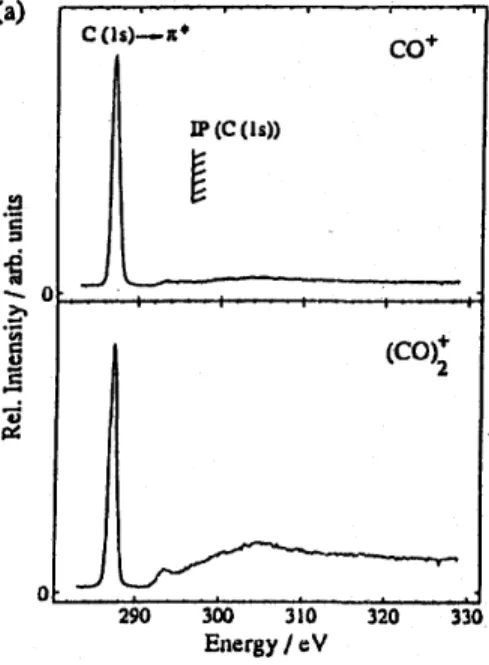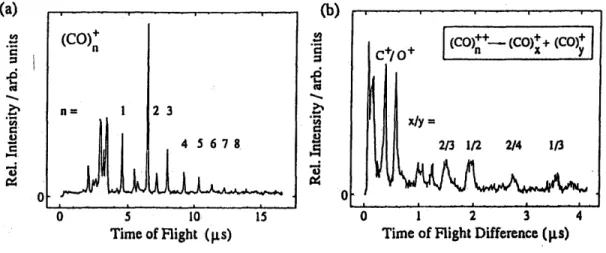Published in : (1991), pp.179-180 Status : Postprint (Author’s version)
Core Level Excitation in Molecular Clusters
E. Rühl, C. Schmale, H. Baumgärtel
Institut fur Physikalische und Theoretische Chemie, Freie Universität Berlin, Takustr. 3, D-1000 Berlin 33 and
R. Locht
Département de Chimie Générale, Université de Liège, Sart-Tilman, B-4000 Liège, Belgium
Core level excitation of weakly bonded molecular complexes is reported. With this technique spectroscopic changes from the isolated species to the condensed phase have been studied in the energy regimes of element K- and L-edges.l,2 Additionally, we have investigated fragmentation pathways of core-excited molecular clusters.3
Figure. 1 shows photoionization efficiency curves of carbon monoxide (CO+) and its dimer ((CO)2 +
) in the energy regime of the carbon K-edge. Both spectra are dominated by the C (ls)→π* transition (287.4 eV). In contrast to the cluster size dependent energy positions of Rydberg states below the argon 2p edges,1,2 we do not observe energy shifts for the C (1s) →π* -valence transition in clusters. This is in agreement with photon stimulated desorption (PSD) of solid carbon monoxide, where no shift relative to the gas phase spectrum is observed. 4
An interesting difference in spectral shape is the decreased intensity of the ls→π* band relative to the K-continuum intensity and changes in spectral shape in the Rydberg regime. The spectrum of the dimer cation mimicks the PSD spectrum of the solid.4 The ion yield curve of CO+ shows also weak contributions of cluster ion fragmentation above 292 eV. This shows that cluster dication fragmentation leads to CO+ as a final product of dissociative double ionization processes above the 1s threshold, which is consistent with the photœlectron-photoion-coincidence (PEPICO) and photoion-photoion-coincidence (PIPICO) spectra shown m Figures 2(a) and 2(b).
Figure 1: Photoionization efficiency curves of CO+ and (CO)2 +
Published in : (1991), pp.179-180 Status : Postprint (Author’s version)
The photochemical behaviour of carbon monoxide clusters is studied with the PEPICO and PIPICO techniques. The dimer cation is the most intensive mass line in the PEPICO spectrum (see Figure 2(a)). This indicates that larger clusters decay predominantly via double ionization into this mass channel. The PIPICO spectrum shows besides the well-known molecular charge separation channel (C++O+) several coincidences corresponding to cluster dication decays (see Figure 2(b). Most products involve asymmetric charge separation into entire molecular and cluster units, as observed for argon clusters.5 The widest portion of the CO+/(CO)2
+
PIPICO channel corresponds to a KER of 2.6(3) eV for a two body dissociation, whereas the peak maximum gives 0.9(2) eV. In terms of charge separation distances in an electrostatic (Coulomb explosion) picture this corresponds to 5.5 Å and 17 Å, respectively. The lower value is twice the molecular diameter, which is the maximum charge separation distance in a linear dimer. The higher value corresponds to a low KER which is probably due to internal excitation of the cluster fragments, as discussed for argon clusters.5
Figure 2: (a) Photoelectron-photoion-coincidence (PEPICO) and (b) photoion-photoion-coincidence (PIPICO) spectra of carbon monoxide clusters at 305 eV excitation energy.
References
1. E. Rühl, H.W. Jochims, C. Schmale, E. Biller, A.P. Hitchcock, and H. Baumgärtel, Chem. Phys. Lett. 178, 558 (1991)
2. E. Rühl, C. Schmale, H. Baumgärtel, P. Aebi, and A.P. Hitchcock, to be published (1992)
3. E. Rühl, C. Schmale, H.W. Jochims, E. Biller, R. Locht, A.P. Hitchcock, and H. Baumgärtel, in: "Synchrotron Radiation and Dynamic Phenomena", in press (1992)
4. R.A.Rosenberg, P.J. Love, P.R. LaRoe, V. Rehn, and C.C. Parks, Phys. Rev. B 31, 2534(1985)

